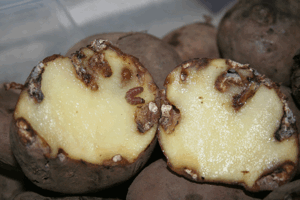Science Note/ Spud Saboteur Turns Good
Air Date: Week of July 16, 2010

Guatemalan potato moth. (Photo: Katja Poveda)
The Guatemalan potato moth has long plagued tuber crops in South America. But as Living on Earth’s Amanda Martinez reports, scientists recently found that a compound in the moths’ saliva can actually more than double potato yields.
Transcript
YOUNG: It’s Living on Earth, I’m Jeff Young. Just ahead – the wide Sargasso Sea – is becoming a wide plastic pool… but first, this Note on Emerging Science from Amanda Martinez.
[THEME]
MARTINEZ: South American potato farmers may soon be able to double their yields. And all it took was a closer look at their biggest nemesis—the Guatemalan potato moth. A potato infested with moth larvae is not a pretty sight. The tiny, rust-colored caterpillars burrow their way through the tuber’s flesh, leaving a trail of brown rot in their wake.
But while the infested spud’s fate may be sealed, other uninfected potatoes on the same plant appear to grow much larger. Scientists at Cornell University believe the source of these super-spuds is the larvae’s saliva. Compounds in the saliva are thought to kick the plant’s photosynthesis into overdrive.

Guatemalan potato moth. (Photo: Katja Poveda)
The reason, researchers believe, is damage control. The infected plant sucks in additional carbon from the air, which causes it to produce more starch and bigger spuds. This, in turn, makes up for those tubers lost to the caterpillars’ voracious appetite. With an increase in yield of up to two-and-a-half times depending on how much of the plant is affected, farmers hopes are up. If the tuber-plumping compound can be isolated, farmers may soon be able to turn the potato-moth pest from a bane into a boon. And that’s this week’s Note on Emerging Science. I’m Amanda Martinez.
Links
Click here to read the paper published in “Ecological Applications”
Living on Earth wants to hear from you!
Living on Earth
62 Calef Highway, Suite 212
Lee, NH 03861
Telephone: 617-287-4121
E-mail: comments@loe.org
Newsletter [Click here]
Donate to Living on Earth!
Living on Earth is an independent media program and relies entirely on contributions from listeners and institutions supporting public service. Please donate now to preserve an independent environmental voice.
NewsletterLiving on Earth offers a weekly delivery of the show's rundown to your mailbox. Sign up for our newsletter today!
 Sailors For The Sea: Be the change you want to sea.
Sailors For The Sea: Be the change you want to sea.
 The Grantham Foundation for the Protection of the Environment: Committed to protecting and improving the health of the global environment.
The Grantham Foundation for the Protection of the Environment: Committed to protecting and improving the health of the global environment.
 Contribute to Living on Earth and receive, as our gift to you, an archival print of one of Mark Seth Lender's extraordinary wildlife photographs. Follow the link to see Mark's current collection of photographs.
Contribute to Living on Earth and receive, as our gift to you, an archival print of one of Mark Seth Lender's extraordinary wildlife photographs. Follow the link to see Mark's current collection of photographs.
 Buy a signed copy of Mark Seth Lender's book Smeagull the Seagull & support Living on Earth
Buy a signed copy of Mark Seth Lender's book Smeagull the Seagull & support Living on Earth

